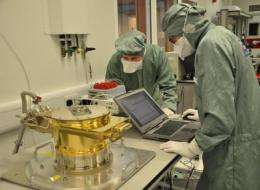Leicester set to fly high in India's first-ever national astronomy mission

Highly specialised equipment constructed at the University of Leicester for India's first national astronomy satellite- Astrosat – is to be handed over to a delegation from India in December.
The five instruments in Astrosat's payload will observe exotic objects and phenomena such as black holes, neutron stars, and active galaxies at a number of different wavelengths simultaneously, from the ultraviolet band to energetic x-rays. Each of its five instruments is looking at different regions of the electromagnetic spectrum which allows simultaneous measurements to be taken across a wide range of energies.
The Indian Space Research Organisation approached the University of Leicester Space Research Centre to undertake the Soft X-ray Telescope (SXT) camera development. Due to Leicester's acclaimed track record in specialised X-ray camera design with successful missions such as SWIFT and XMM-Newton, the University was able to provide the expertise and support to build the CCD camera for the SXT on Astrosat.
The University of Leicester has invested a significant amount of expertise into this Anglo-Indian collaboration of which Guy Peters, Astrosat Project Manager-UK said: "Leicester's involvement with Astrosat is hugely significant, not just for the University, but for Leicester as a whole. It speaks volumes for the scientific and technological expertise housed at the University of Leicester that we have been sought-out to develop this equipment. It is something the whole city can be proud of."
The event on 5th December will not only be attended by the Indian and UK Astrosat teams, but also by Professor Sir Robert Burgess, Vice-Chancellor of the University of Leicester, Deputy Mayor Councillor Ted Cassidy and members of the Indo British Trade Council and local councillors.
Mr Peters said: "The event will showcase the importance placed on successful collaborations between the UK and India and more importantly the partnership between the University of Leicester's Space Research Centre, TIFR and the Indian Space Research Organisation, sowing the seeds for future collaborative missions.
"Following this visit, we will fly over to India for the final test of the CCD camera for the SXT before the expected launch in 2012."
Professor K. P Singh, Principal Investigator for the SXT from Mumbai, will be talking at the event about how important this mission is for India and highlight the pride the Indian Astrosat Team feel, seeing their original concept come closer to launch date. He will also discuss what this means 'on the ground'-how Astrosat can better enable us to understand space and its many phenomena.
Guy Peters added that he hoped the success of this mission will pave the way for many more missions to come-"Here in Leicester we are a young team gaining experience on a major project. Astrosat has provided a really exciting opportunity for the team and we hope the success of this mission will provide opportunities for further collaborations in the future".
Provided by University of Leicester




















